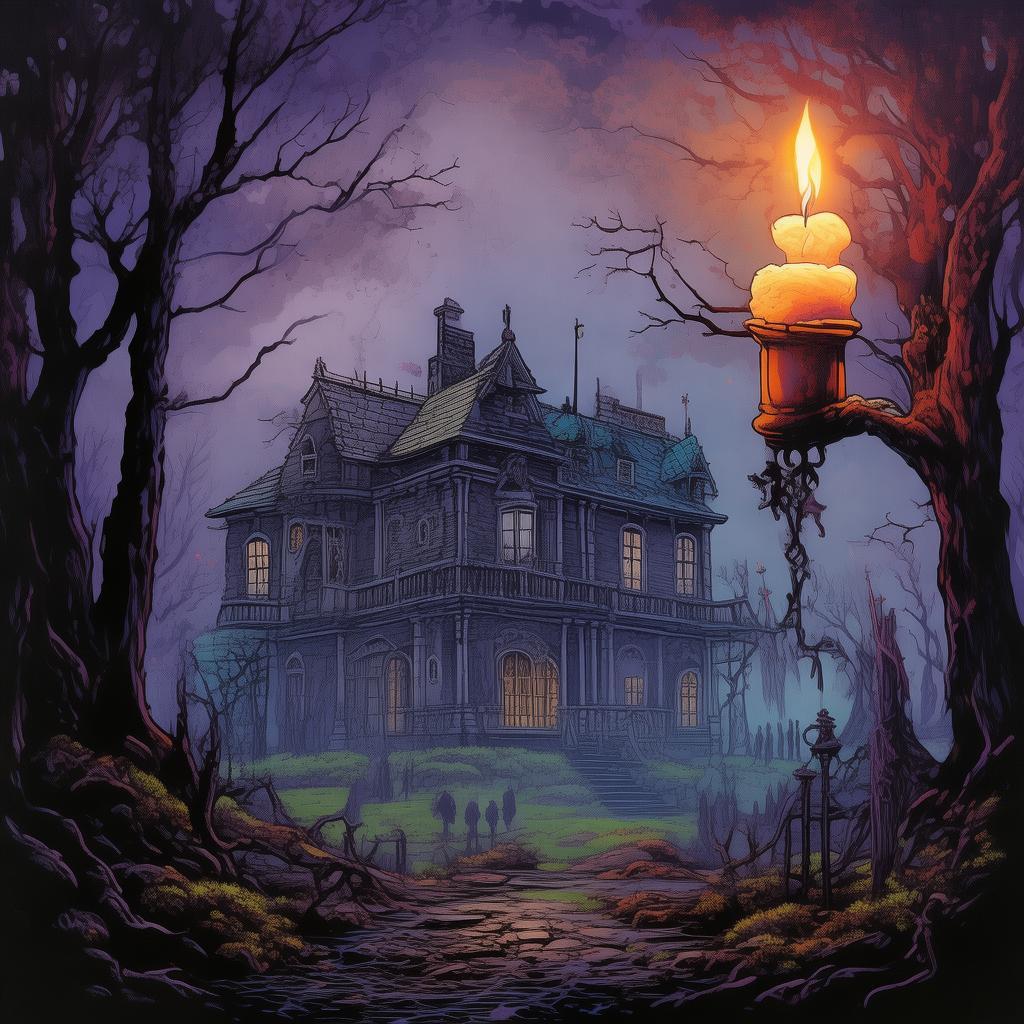Ghostly Whispers: A Picture's Sinister Secret
In the heart of a quaint English village, nestled among cobblestone streets and ancient trees, stood the stately manor of the Harrisons. It was a place of whispered legends and hidden histories, where time seemed to stand still. The manor was home to the enigmatic and reclusive artist, Eliza Harrison, whose works were both celebrated and shrouded in mystery. It was said that her paintings held a peculiar quality—their subjects seemed to move and whisper secrets from beyond the canvas.
One crisp autumn evening, Eliza was sorting through her late mother's belongings when she stumbled upon a photograph that had been carefully tucked away in a dusty drawer. The image was of a young woman, her face obscured by a veil, standing in front of a grand, old mansion. The caption read, "Eliza, 1887." The woman in the photograph bore a striking resemblance to Eliza herself, and it was then that the chilling whispers began.
As Eliza held the photograph, she felt a strange sensation, as if the woman in the image was reaching out to her across the decades. The whispers grew louder, more insistent, and Eliza realized that the photograph held a sinister secret that was bound to her family's past.
? Opening: Explosive Hook
Eliza's mother had always spoken of a tragic love story, one that had ended in heartbreak and madness. It seemed that her great-grandmother, also named Eliza, had been in love with a man who was not to be hers. The whispers, Eliza concluded, were the spirits of her ancestors, calling out for justice and truth.
⚡ 2. Setting Up Conflict
Determined to uncover the truth, Eliza began her investigation. She visited the old mansion in the photograph, now a dilapidated ruin, and discovered that it was once the home of her great-grandparents. As she explored the decaying halls, she found a hidden room filled with portraits of her ancestors, each one with a haunting resemblance to the woman in the photograph.
The more Eliza delved into the past, the more she uncovered a web of deceit and betrayal. Her great-grandmother had been promised in marriage to a man she did not love, and in a desperate act of defiance, she ran away with the man she loved. Their love was forbidden, and when her great-grandmother's family found her, they sought to punish her by sending her to an asylum.
⚀ 3. Development: Attempts to Solve the Problem
Eliza's great-grandmother was confined to the institution, where she died in a fire, and her lover was never seen again. The whispers grew louder, demanding Eliza's attention. She felt a deep connection to her great-grandmother, and the photograph became a key to unlocking the past.

Eliza's investigation led her to a local historian, who revealed that the mansion had been the scene of a series of mysterious deaths. It was said that the spirits of those who had died there still roamed the halls, seeking release from their tragic fates.
? 4. Climax: The Most Tense and Dramatic Turning Point
Eliza's determination to uncover the truth led her to the very room where her great-grandmother had perished. As she stood in the room, the whispers grew louder, and she felt a presence around her. Suddenly, the portrait of her great-grandmother began to move, and the woman's eyes seemed to lock onto Eliza's.
In that moment, Eliza realized that the photograph was not just a memory; it was a key to communicating with the spirits of her ancestors. The woman in the portrait was reaching out to her, and she was the only one who could free them.
? 5. Conclusion: Wrap Up with a Twist
Eliza took a deep breath and reached out to the portrait, placing her hand against the canvas. The portrait began to glow, and the whispers grew quieter, until they faded away completely. The woman in the portrait smiled, and Eliza felt a sense of peace wash over her.
In the days that followed, Eliza found herself able to communicate with the spirits of her ancestors. They told her stories of love, loss, and the pain of their final moments. Through their stories, Eliza learned that her great-grandmother's love had been pure and true, and that she had been betrayed by those she trusted most.
Eliza returned the photograph to its rightful place in her mother's drawer, but the whispers remained with her, a reminder of the connections we have to the past. She realized that the photograph was not just a relic of the past; it was a testament to the enduring power of love and the strength of the human spirit.
As the story of Eliza and the photograph spread through the village, it became a cautionary tale of the hidden secrets that lie within our family histories. It was a story that would be told for generations, a reminder that sometimes the past is not as far away as we think.
✨ Original Statement ✨
All articles published on this website (including but not limited to text, images, videos, and other content) are original or authorized for reposting and are protected by relevant laws. Without the explicit written permission of this website, no individual or organization may copy, modify, repost, or use the content for commercial purposes.
If you need to quote or cooperate, please contact this site for authorization. We reserve the right to pursue legal responsibility for any unauthorized use.
Hereby declared.









